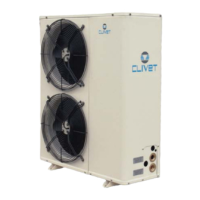Do you have a question about the CLIVET WSAN-EE 41 and is the answer not in the manual?
Describes the unit's identification label, listing type, serial number, year of manufacture, and technical data.
Highlights internal and external danger zones around the unit requiring authorized personnel access.
Details potential hazards such as burning, smoke, contact with hot parts, and improper repairs.
Outlines risks associated with electrical connections, grounding, and component access.
Presents technical electrical specifications like voltage, current, and power input for various unit sizes.
Details the procedures for safely connecting the unit to the main power supply.
Lists essential checks covering the unit's installation, power supply, and components before startup.
Outlines procedures for checking the refrigerant circuit's pressure and integrity.
Describes checks for the water system, including flushing, pressure testing, and air bleeding.
Classifies alarms into electrical, refrigerant, and water categories, indicating their status.
Details the procedure for resetting alarms after the cause has been identified and eliminated.
Outlines specific maintenance tasks for key components like structure, coils, fans, and exchangers.
Provides tables with refrigerant circuit parameters for testing operation by detecting pressure and temperature.
Lists potential causes for high pressure alarms in cooling mode, such as temperature or fan issues.
Identifies potential causes for low pressure alarms in cooling, including flow issues or refrigerant charge.
Describes the unit's identification label, listing type, serial number, year of manufacture, and technical data.
Highlights internal and external danger zones around the unit requiring authorized personnel access.
Details potential hazards such as burning, smoke, contact with hot parts, and improper repairs.
Outlines risks associated with electrical connections, grounding, and component access.
Presents technical electrical specifications like voltage, current, and power input for various unit sizes.
Details the procedures for safely connecting the unit to the main power supply.
Lists essential checks covering the unit's installation, power supply, and components before startup.
Outlines procedures for checking the refrigerant circuit's pressure and integrity.
Describes checks for the water system, including flushing, pressure testing, and air bleeding.
Classifies alarms into electrical, refrigerant, and water categories, indicating their status.
Details the procedure for resetting alarms after the cause has been identified and eliminated.
Outlines specific maintenance tasks for key components like structure, coils, fans, and exchangers.
Provides tables with refrigerant circuit parameters for testing operation by detecting pressure and temperature.
Lists potential causes for high pressure alarms in cooling mode, such as temperature or fan issues.
Identifies potential causes for low pressure alarms in cooling, including flow issues or refrigerant charge.











